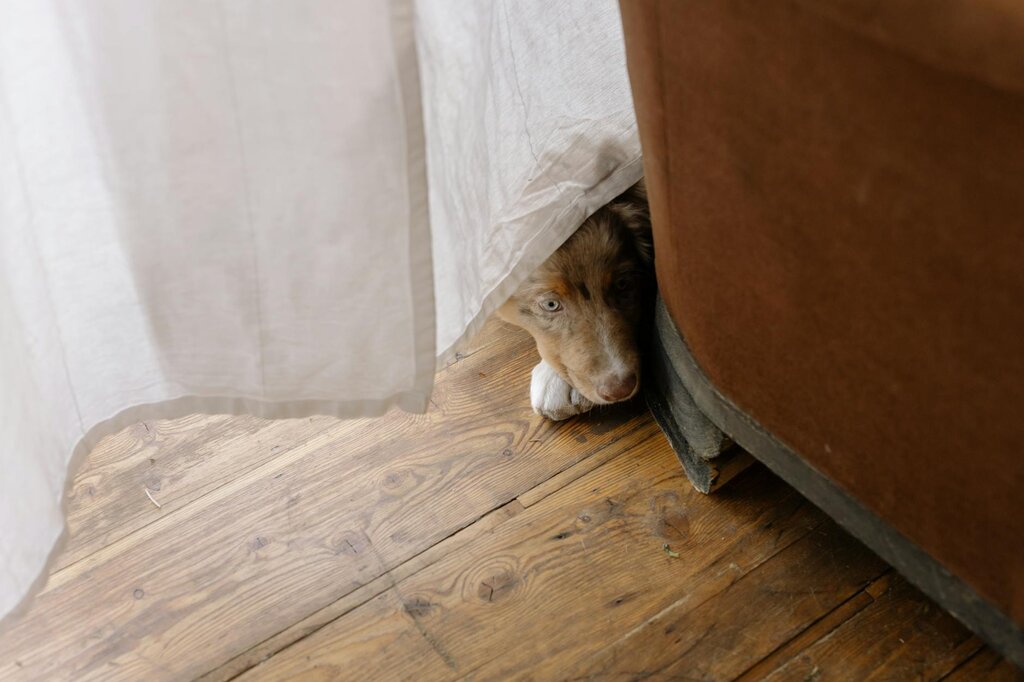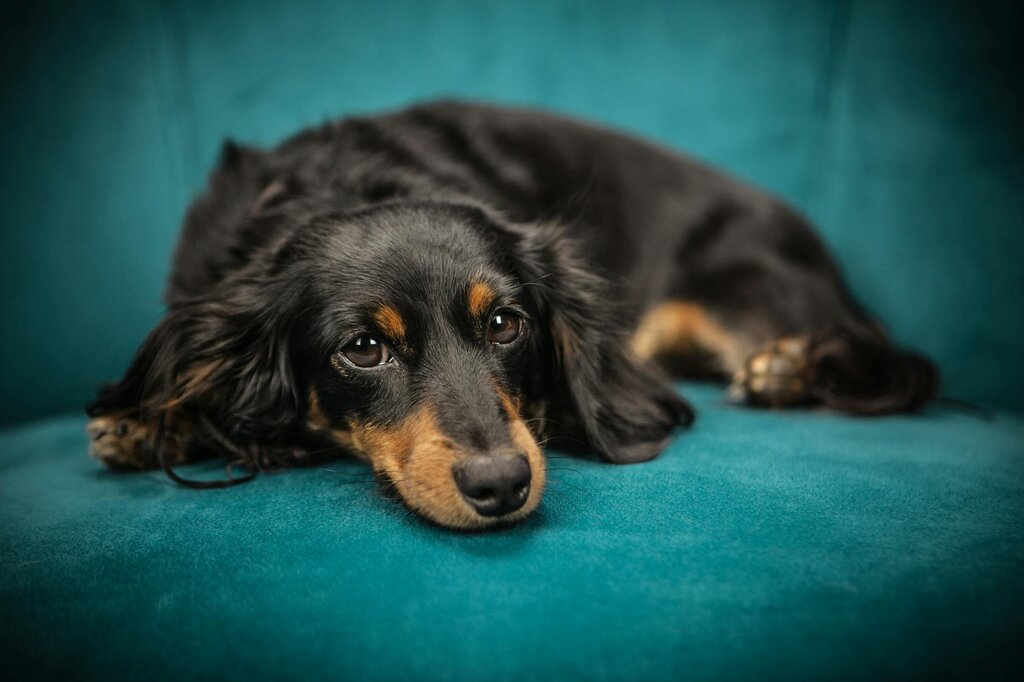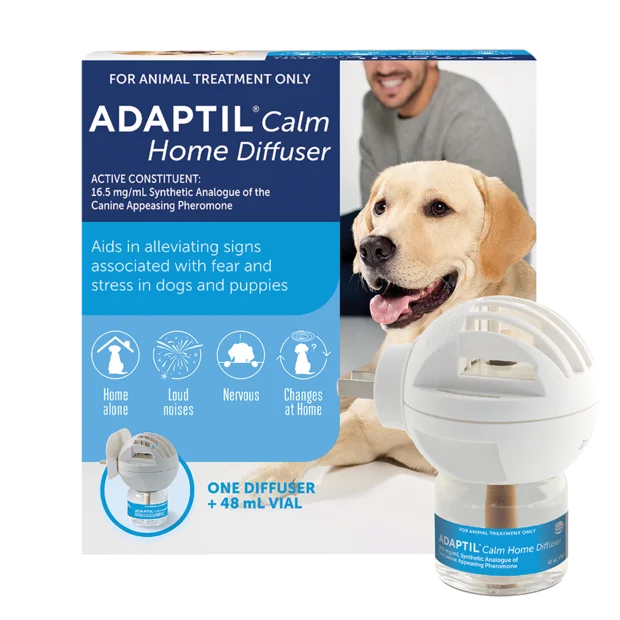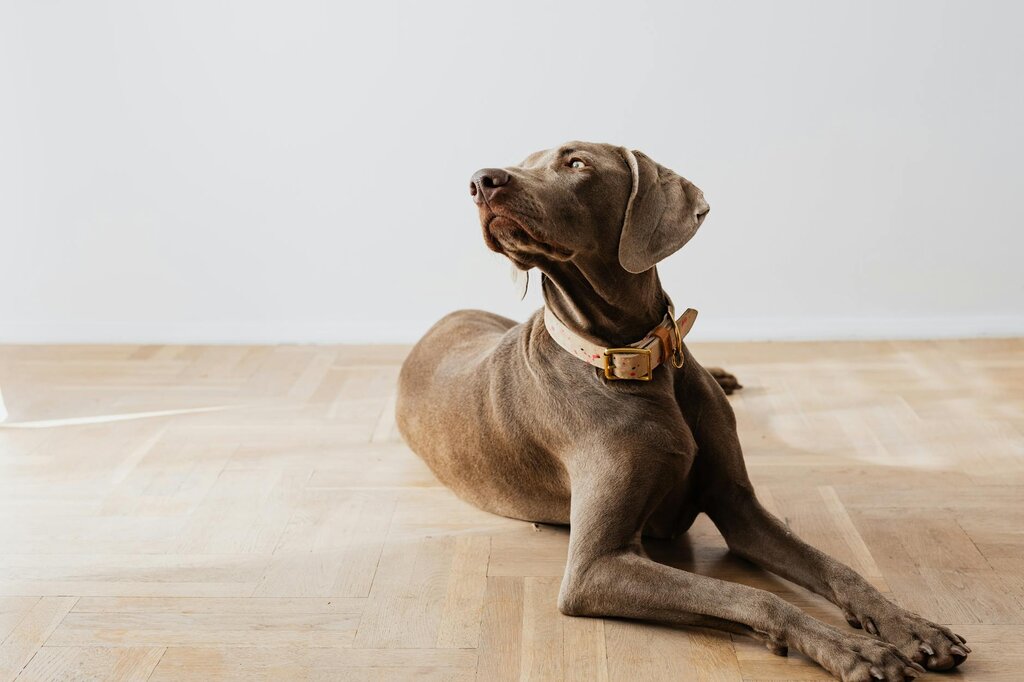Last Updated: 12/11/2025
Dog Noise Anxiety: A Vet's Guide to Storms & Fireworks
Why are dogs scared of storms and fireworks? Discover the signs of noise phobia and explore vet-recommended strategies, from calming supplements and anxiety wraps to behaviour training, to help manage your dog's anxiety.
Author: Dr Carla Paszkowski BVSc (Hons)
Reading Time: 10 minutes - short read
The rumble of distant thunder, the sudden crack of fireworks, or even the howl of strong wind can be incredibly stressful for many dogs. For a pet parent, watching your dog pace, tremble, and hide during a noisy event is a heartbreaking experience.
This fear is common, but it's more than just a dislike of loud sounds - it’s a genuine phobia. Understanding why this happens is the first step to helping your dog cope. This guide will explore the signs of noise phobia and provide practical, vet-approved strategies to help manage your dog's anxiety.
In this article
What is a noise phobia in dogs?

A phobia is a markedly exaggerated irrational response to a stimulus. They develop from fears, and therefore most likely have a survival benefit for the animal. For example, it's a good thing to fear snakes but it's not good to be phobic of them. The stimulus that triggers a phobic response is often innocuous, as is the case with storm phobias and may be related to a change in barometric pressure or small rain showers.
Why are dogs afraid of storms?
Experts aren't totally sure exactly why dogs are afraid of storms, but suspect the dogs are stressed by some combination of:
- Wind
- Loud noises
- Barometric pressure changes
- Smell of the storm
- Static electricity
- Low-frequency rumbles
Curiously, many dogs seem to sense the storm before it starts and according to one theory, dogs experience painful shocks from static buildup before the storm.
Static buildup in their fur is a possible explanation, says Nicholas Dodman, chief scientific officer at the Centre for Canine Behaviour Studies. Dogs who have experienced static shocks when their noses touch metal objects during a storm may remember this uncomfortable experience and develop a phobia thereafter. This is more common in dogs with a high intelligence and good memory such as the Border Collie, and also in dogs with long or double coats (similar to humans getting a shock when they wear a thick jumper). Their sense of smell could also contribute - it's likely that their incredible noses may just be smelling changes in the air that indicate a storm is coming.
Common signs of anxiety
- Licking lips
- Panting
- Shaking or trembling
- Refusing to eat
- Restlessness
- Barking
- Aggression
- Destroying furniture
- Urinating in an inappropriate place
How to help your dog with storm and noise phobia

Managing a pet's phobia of storms or fireworks requires a layered approach. These are complex behavioural issues with no single solution, so the best results usually come from combining several different strategies.
Creating a 'safe haven'
Monitoring weather websites and apps during the storm season can allow you to predict to some degree the risky times for your dog. It is also beneficial to check your local council's website for upcoming fireworks events.
In preparation for storms or fireworks, you can bring them inside and into a safe area where they can't injure themselves. Ideally, this safe haven is a quiet, darkened room with no sharp objects or furniture that may cause injury. If your dog has a particular area they choose to go to during these times, it's best to allow them to do so as long as it's safe.
Calming diets
For dogs with chronic anxiety, a calming diet can be a supportive long-term solution. Royal Canin Relax Care is an over-the-counter specific anxiety dog food formulated to help dogs cope with stress.
It uses fish hydrolysate, a natural fish protein with demonstrated calming effects. A study showed that after 6 weeks on this diet, over 44% of dogs behaved normally in changing situations. It is available as both kibble (dry food) and wet food for small, medium, and large breeds.
For dogs 15kg and under who require more support, Royal Canin also make a veterinary/prescription calming diet - Royal Canin Calm. This diet contains hydrolysed milk protein and adapted L-tryptophan levels to promote calmness, providing relief from anxiety and stress-related digestive, skin, or urinary issues.
Calming supplements

For dogs with noise phobias, certain supplements (also called nutraceuticals) can help promote a sense of calm.
Here are some of the most common options:
- Zylkene: This is a popular natural supplement in an easy-to-give capsule. It contains a product derived from casein, which is the milk protein known for its natural calming effect on newborns during breastfeeding.
- Tryptophan-based products: Tryptophan is a natural ingredient that the body uses to make serotonin (often called the 'happy hormone' which helps regulate mood and anxiety). Products like PAW Blackmore's Complete Calm Chews and ThunderWunder Calming Chews use tryptophan along with B vitamins and can be used daily for long-term support.
- Hemp-based products: Many pet owners find hemp products helpful for anxiety. These do not contain CBD or THC. Instead, hemp seeds are a rich source of omega fatty acids.
- Chamomile products: This well-known natural herb may help in some cases.
Pheromone diffusers and collars
Pheromones are natural calming "messages" that animals use to communicate. They are unique to each species and help create a sense of safety and emotional well-being.
A key example is the Dog Appeasing Pheromone (DAP). Mother dogs naturally release this from their mammary glands after birth to make their new puppies feel safe, calm, and secure.
A synthetic version of this comforting pheromone is available as Adaptil. It's a safe, non-sedating tool that can help your dog feel more secure during storms or fireworks. It comes in several convenient forms:
- Adaptil Collar: ideal for dogs who need constant support, as it stays with them. It must fit snugly against the skin to be activated by your dog's body heat.
- Adaptil Diffuser: perfect for indoor "safe havens," releasing the calming pheromone into the room where your dog spends the most time.
- Adaptil Spray: useful for creating a temporary safe spot. You can apply it to your dog's bedding, crate, or anxiety wrap. It works quickly (once the alcohol evaporates) and lasts for about two hours.

For more information, take a read through Your Guide to Using Adaptil.
Anxiety wraps
Anxiety wraps like the ThunderShirt work by applying gentle constant pressure to the sides of the torso, helping to relieve stress and reduce fearfulness. This concept is similar to 'swaddling', the art of snugly wrapping a baby in a blanket for warmth and security. These body wraps are safe and easy to use, with a range of sizes to suit all dogs.
Behavioural training techniques

Proactive training before the storm season begins can make a significant difference. Dogs thrive on routine, so consistency is the most important part of this process.
1. Practising calm or 'settle' training
The goal is to teach your dog to associate a specific spot, like their bed, with being calm and relaxed.
- Choose a spot: Find a comfortable spot, like your dog's bed, and place it in their 'safe haven' (the quiet, darkened room mentioned earlier).
- Practise daily: A few times each day, ask your dog to go to their bed and sit or lie down.
- Reward immediately: The moment they are calm on their bed, reward them. This can be a high-value treat, a favourite toy, or gentle patting.
- The goal: You are building a strong positive association with this spot. This way, when a storm hits, you can ask them to go to their "calm" place and reward them for doing so.
2. Desensitisation
This is a specific technique that involves exposing your pet to their trigger (the scary noise) at an extremely low level - so low that they do not have a fearful reaction.
- How it works: You might play a thunder soundtrack on your phone at a barely audible volume while your dog is relaxed.
- Go slowly: Over many days or weeks, you can gradually increase the volume, but only as long as they continue to show zero signs of anxiety.
Important note: Desensitisation is less effective for dogs who react to multiple storm triggers (like changes in barometric pressure, static, or lightning) as these can't be replicated with a soundtrack.
3. Counter-conditioning
This technique aims to change your dog's emotional response to the scary noise. You are "pairing" the sound with something wonderful, effectively changing their association from "That sound is terrifying!" to "That sound means I get chicken!"
- How it works: While the scary sound (e.g., a thunder soundtrack) is playing at a very low, non-threatening level, you actively give your dog high-value treats or play their favourite game.
- The goal: The dog begins to associate the sound of thunder with the positive experience of treats or play. Like desensitisation, you can gradually increase the sound's intensity over time.
Warning: Never punish your dog for showing fearful behaviour during this or any other time. It will only increase their anxiety and make the phobia worse.
For more information, check out our guide to How to Calm an Anxious Pet.
When to see your vet

You should see your vet if your dog's anxiety is severe (e.g., destructive behaviour, self-harm, or inability to be calmed), or if the strategies you've tried aren't helping. Your vet can discuss prescription medications, recommend a veterinary behaviourist, and rule out any underlying medical issues that might be contributing to the anxiety.
If your vet prescribes prescription medications, these medications will need to be administered at least an hour prior to the storm to be most effective.
If your veterinarian determines that your pet's storm phobia may be related to other behavioural issues, they may also prescribe a daily anti-anxiety medication.
FAQs
Dealing with a noise phobia in your dog, whether it's to storms or fireworks, can be challenging. The key is often finding the right combination of strategies that works for your individual pet.
By proactively preparing for noisy events, creating a safe space, using calming aids, and practising positive behaviour modification, you can significantly reduce your dog's distress. If your dog's anxiety is severe or not improving, always consult your veterinarian. They can provide a tailored plan, discuss prescription options, and rule out any other medical issues.
Articles recommended for you
Our vet authored guide to the benefits of feeding your dog fresh food plus tips and advice for introducing it into their regular menu.
See our guide to protecting your pet from parasites from our vet team.
Thinking of getting a fish? Check out our guide for setting up a tank and home care tips!
Looking to understand horse feeds better? This comprehensive guide covers feeding recommendations for horses of all ages and disciplines.
Does your pet suffer from anxiety? Check out our Vet-guide for treatment options to help your pet.
History
Our experts continually monitor the health and wellness space and we update our articles when new information becomes available.
Wed 12 Nov 2025
Edited by Dr Gillian Hill BVSc (Hons)Dr Carla Paszkowski BVSc (Hons)
Veterinarian
Dr. Carla graduated from the University of Queensland in 2013 with a Bachelor of Veterinary Science and worked for a number of years in small animal clinics across South East Queensland. While Carla enjoys most facets of clinical veterinary work, she holds a special passion for feline medicine, pocket pets, and nutrition.

